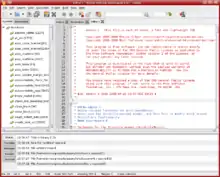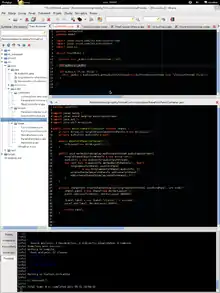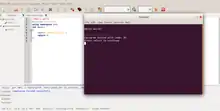Geany
Geany (IPA:dʒiːni[4] JEE-NEE) is a free and open-source lightweight GUI text editor[5] using Scintilla and GTK, including basic IDE features. It is designed to have short load times, with limited dependency on separate packages or external libraries on Linux. It has been ported to a wide range of operating systems, such as BSD, Linux, macOS,[6] Solaris and Windows. The Windows port lacks an embedded terminal window; also missing from the Windows version are the external development tools present under Unix, unless installed separately by the user.[7] Among the supported programming languages and markup languages are C, C++, C#, Java, JavaScript, PHP, HTML, LaTeX, CSS, Python, Perl, Ruby, Pascal, Haskell, Erlang, Vala and many others.[8]
 | |
 | |
| Original author(s) | Enrico Tröger |
|---|---|
| Developer(s) | Geany authors |
| Initial release | October 19, 2005 |
| Stable release | |
| Repository | |
| Written in | C, C++[2] |
| Operating system | Linux macOS Windows |
| Size | 14 MB (Windows) |
| Type | IDE |
| License | GPL-2.0-or-later[3] |
| Website | geany |

In contrast to traditional Unix-based editors like Emacs or Vim, Geany more closely resembles programming editors common on Microsoft Windows such as Notepad++, which also uses Scintilla.[9]
It is free software licensed under the terms of the GNU GPL version 2 or later.[3] In 2012, the version number was increased to 1.22 from 0.21 to reflect the maturity of the product, as requested by many users.[10] Geany Version 1.29 is based by GTK+ 3.22.[11] Version 1.36 is based by GTK+ 3.24.14.[12] Version 1.37.1 is last Version with GTK+ 2.24 support.[13]
Features

- Auto-completion
- Bookmarks (called markers)
- Multiple document support
- Simple project management
- Syntax highlighting
- Code folding (partially)
- Symbol lists
- Code navigation
- Embedded terminal emulator[14]
- Build system to compile and execute code using external tools
- Extensible via plugins
- Column / block / vertical select (via Shift + Ctrl + arrow keys)
- User configurable keyboard action to editor function mapping[15]
Rankings
In 2018, Geany entered the top 10 integrated development environments for Python in The Indian Wire.[16] In 2021, Geany was named as one of the 12 best Linux text editors in Fossbytes.[17]
References
- "Release Geany 2.0 · geany/geany". GitHub. 19 October 2023. Retrieved 23 October 2023.
- "geany/geany: A fast and lightweight IDE". GitHub. 11 July 2016. Retrieved 2016-07-11.
- "geany/README at master · geany/geany · GitHub". github.com/geany/geany. Archived from the original on 2021-06-22. Retrieved 2021-06-22.
- "Geany's FAQ: How do you pronounce Geany?".
- "Fast, powerful Geany editor offers IDE features". Linux.com. Archived from the original on 2009-02-08. Retrieved 2014-02-03.
- "geany.darwinports.com". geany.darwinports.com. Archived from the original on 2010-02-16. Retrieved 2014-02-03.
- "Running Geany on Windows". Geany. Retrieved 2020-01-01.
- "Supported Filetypes". Geany. Retrieved 2020-01-01.
- "Notepad++ and Scintilla". Archived from the original on 2019-02-19. Retrieved 2019-02-18.
- "Geany news archive".
Many users told us our version numbers didn't reflect the maturity of Geany to their eyes, and wished it to be changed to reflect that. So after some discussion we decided to rename this version 1.22 instead of 0.22.
- "Geany 1.29 is Released with Improved GTK 3.22 Support". 15 November 2016.
- "Release Notes | Geany".
- "Geany-gtk2 Download (TXZ)". Archived from the original on 2021-09-10. Retrieved 2021-04-02.
- "Freelancer's Playground! | Using Geany's VTE". bayu.freelancer.web.id. 2008-08-26. Archived from the original on 2011-09-10. Retrieved 2014-02-03.
- "Geany".
- Prashant Kumar (5 July 2018). "List of top 10 best IDEs for Python Development". The Indian Wire. Retrieved 5 July 2018.
- Adarsh Verma (11 May 2021). "12 Best Linux Text Editors For Programming In 2021". Fossbytes. Retrieved 11 May 2021.